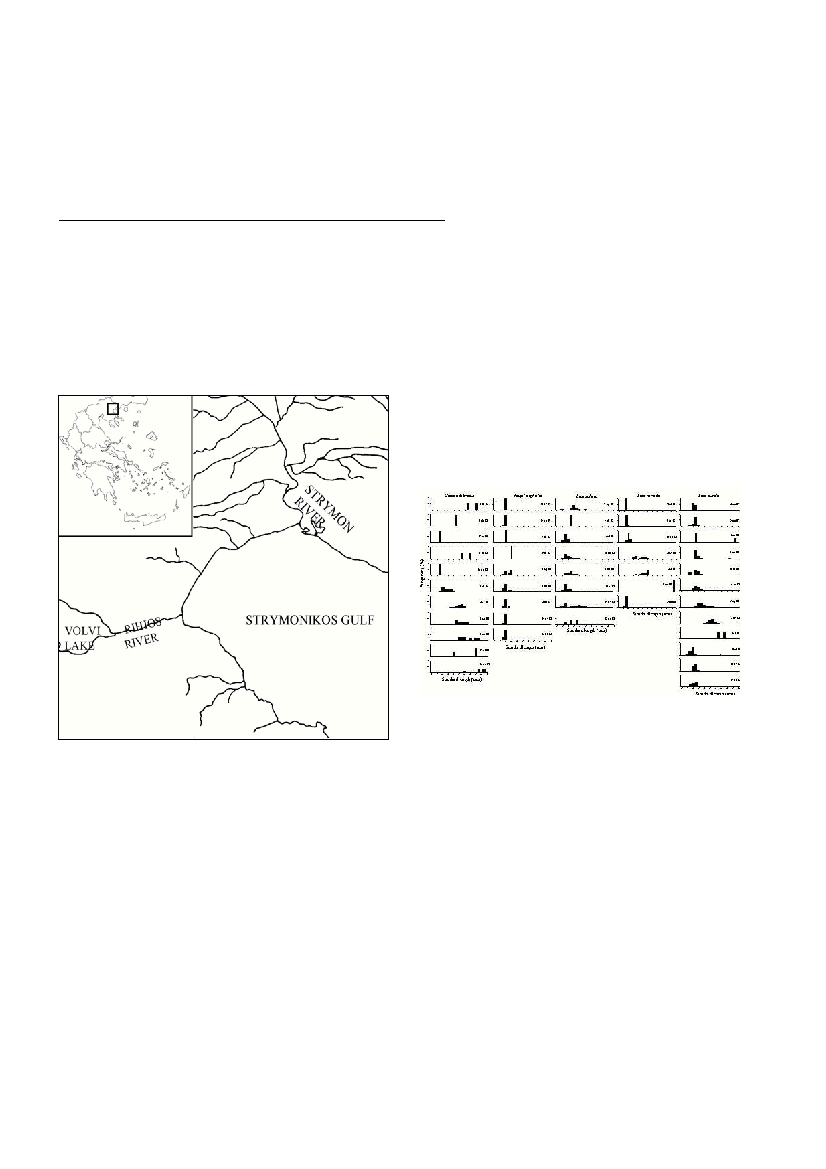Rapp. Comm. int. Mer Médit., 36,2001
289
Introduction
The five species of Mugilidae that occur in the Greek coastal waters
are commercially important fish and constitute a significant part of the
fish production in the Mediterranean, especially in lagoons.
The two estuarine systems where the study was carried out were
those of Strymon and Rihios, which are the two main rivers ?owing
into the Strymonikos Gulf (Fig. 1). Strymonikos Gulf is located at the
northwestern part of the Aegean Sea, occupying an area of 540 km
2
.
Strymon River, one of the three most important rivers in Northern
Greece, originates from Bulgaria and ?ows to the northern part of the
gulf. Rihios is a small river with a steady ?ow throughout the year that
drains the lakeVolvi.
Figure 1. Map of the study area.
Materials and methods
Samplings were carried out on a monthly basis from September
1997 to December 1998. Four sampling stations were selected, two in
each estuarine system. A bag seine net of 20 m length and 2 mm mesh
size was used for the collection of the samples.
Results
With respect to the Strymon estuarine systems, members of the
Mugilidae family were among the most abundant species, accounting
for 41.8% of the total catch [1]. In Rihios estuary, Mugilidae account-
ed for 29.1% of the total catch. A total of 3,515 juveniles of grey mul-
lets were caught. The monthly size distribution of the juveniles is
shown in Fig. 2. Chelon labrosusaccounted for 5.4% of Mugilidae
catch in Rihios and for 5.2% in Strymon estuary.The first appearance
of the fry occurred in March 1998 but the smallest individuals were
caught in May 1998 (SL= 15-66 mm). Fry catches continued till
November 1998 when length reached 99 mm. Mugil cephalusper-
centage of the total Mugilidae catch reached 14% in Rihios and 13.9%
in Strymon estuary.The juveniles first appeared in August 1998 but
the smallest individuals were caught in October 1998 (SL= 17-29 mm)
and November 1998 (SL= 17-41 mm). Fry catches continued till
December 1998 but maximum standard length (41 mm) was observed
in November 1998. Liza saliensexhibited the highest percentage in the
total Mugilidae catch in Rihios system (45.8%) and the lowest in
Strymon with 3.8% of the mullet catch. The first appearance occurred
in July 1998 but the smallest individuals were caught in August 1998
(SL= 8-45 mm). The catch of L. saliensjuveniles continued till
December 1998. The biggest specimen was caught in November 1998
(78 mm). The percentage of L. ramadain the total Mugilidae catch in
Rihios was 10.7% and in Strymon reached 17.4%. The smallest indi-
viduals were caught in December 1998 (SL= 14-20 mm). In 1997 the
fry catches continued till the following September when juvenile
length reached 112 mm. The percentage of L. auratain the total
Mugilidae catch in Strymon was the highest recorded in the present
study (59.6%) and the second higher in Rihios system (24.4%). The
smallest individuals were caught in October 1998 (SL=10-26 mm). In
1997 the first appearance of the fry occurred in November and fry
catches continued till next July when standard length reached 75 mm.
Figure 2. Size composition of the juveniles of the five Mugilidae
species caught in Strymonikos Gulf between September 1997
and December 1998.
Discussion
The first appearance of each grey mullet species occurred in differ-
ent months of the year but in general follows the same order in the
Mediterranean with 1-2 months variation [2]. The first Mugilid species
which appeared during the year near the coasts of Strymonikos Gulf
wasC. labrosusin March, followed by L. saliensin July, by M.
cephalusin August and then by L. auratain October.The juveniles of
L. ramadaappeared last, in November. Results from a similar study in
another lagoon of Northern Greece [2], reported the same order of
appearance shifted 1-2 months later in the year than in Strymonikos
Gulf.
References
1. Koutrakis E.T., Kokkinakis A.K., Eleftheriadis E.A. and Argyropoulou
M.D., 2000. Seasonal changes in distribution and abundance of the fish
fauna in the two estuarine systems of Strymonikos Gulf (Macedonia,
Greece).Belg. J. Zool., 130 (Suppl. 1) : 41-48.
2. Koutrakis, E.T., Sinis A.I. and Economidis P.S., 1994. Seasonal
occurrence, abundance and size distribution of grey mullet fry (Pisces,
Mugilidae) in the Porto-Lagos lagoon and LakeVistonis (Aegean Sea,
Greece).Isr. J.Aquac.- Bamidgeh, 46(4) : 182-196.
SEASONAL OCCURRENCE AND SIZE DISTRIBUTION OF GREY MULLET FRY (PISCES, MUGILIDAE)
IN STRYMONIKOS GULF (GREECE)
E.T. Koutrakis
Fisheries Research Institute, National Agricultural Research Foundation, Kavala, Greece - fri@otenet.gr
Abstract
The seasonal occurrence and size distribution of mullet fry was studied in the two estuarine systems of Strymonikos Gulf (Northern Aegean
Sea). Samplings were carried out on a monthly basis between September 1997 and December 1998 using a bag seine net. Five species of
Mugilidae were caught : the common grey mullet (Mugil cephalus), the thick-lipped mullet (Chelon labrosus), the thin-lipped mullet (Liza
ramada), the golden mullet (L. aurata) and the leaping mullet (L. saliens).
Keywords : Aegean Sea, Eastern Mediterranean, fishes, estuaries, migration.

